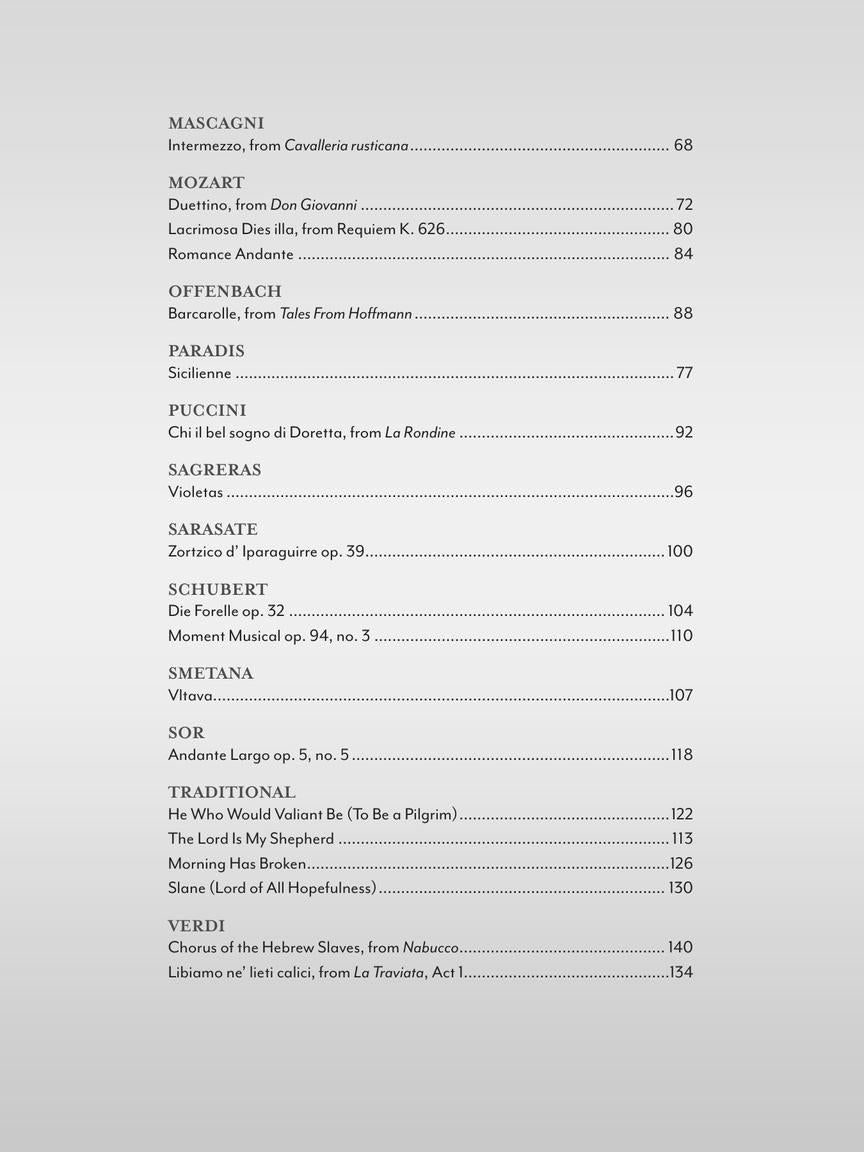Masterful Arrangements for Classical Guitar
In stock and typically ships within 1 business day.
- Composers: George Frideric Handel (1685-1759), Wolfgang Amadeus Mozart (1756-1791), Johann Sebastian Bach (1685-1750), Scott Joplin (1868-1917), Maria Theresia von Paradis (1759-1824), Frédéric Chopin (1810-1849), Robert Lowry (1826-1899), Pietro Mascagni (1863-1945), Enrique Granados (1867-1916), Giacomo Puccini (1858-1924), Pablo de Sarasate (1844-1908), Bedřich Smetana (1824-1884), Giuseppe Verdi (1813-1901), Marc-Antoine Charpentier (1643-1704), Franz Schubert (1797-1828), Christoph Willibald Gluck (1714-1787), Jacques Offenbach (1819-1880), Johannes Brahms (1833-1897), Antonín Dvořák (1841-1904), Mauro Giuliani (1781-1829), Léo Delibes (1836-1891), Fernando Sor (1778-1839), Julio S. Sagreras (1879-1942), Anton Bruckner (1824-1896), Gabriel Fauré (1845-1924)
- Arranger: Bridget Mermikides
- Format: Book & Audio Access
- Instrumentation (this edition): Guitar
- Originally for: Piano, Violin, Voice, Piano 4-Hands, SATB Choir, Orchestra, Guitar, String Orchestra, Opera
- ISBN:
- Size: 9.0 x 12.0 inches
- Pages: 144
Description
35 beautiful pieces superbly recorded and arranged for solo classical guitar in standard notation and tablature by Bridget Mermikides. Recordings of Bridget playing each piece are accessed online for download or streaming.
Works include:
- Andante Largo, Op. 5, No. 5 (Sor)
- Andante - Violin Sonata No. 2 (Bach)
- Coppélia Waltz (Delibes)
- The Entertainer (Joplin)
- How Can I Keep from Singing (Lowry)
- Humoresque (Dvořák)
- Sicilienne (Paradis)
- Tristesse, Op. 10, No. 3
- Waltz No. 15, Op. 39 (Brahms)
- He Who Would Valiant Be (To Be a Pilgrim) (Traditional)
- The Lord Is My Shepherd (Traditional)
- Morning Has Broken (Traditional)
- Slane (Lord of All Hopefulness) (Traditional)
- and more.
Works:
- Andante from Bach: Violin Sonata No. 2 in A Minor, BWV 1003
- No. 15 from Brahms: 16 Waltzes, Op. 39
- Bruckner: Locus iste, WAB 23
- Prelude from M.A. Charpentier: Te Deum, H 146
- Chopin: Etude in E Major, Op. 10, No. 3
- Waltz from Delibes: Coppélia
- No. 7 from Dvořák: Humoresques (Humoresky), B. 187, Op. 101
- Songs My Mother Taught Me, No. 4 from Dvořák: Gypsy Songs (Cigánské melodie), B. 104, Op. 55
- Pie Jesu from Fauré: Requiem in D Minor, Op. 48
- Giuliani: La Rose, No. 9 from Choix de mes fleurs chéries, Op. 46
- Dance of the Blessed Spirits from Gluck: Orfeo ed Euridice (Italian Version), Wq. 30
- La Maja de Goya from Granados: 12 Tonadillas en estilo antiguo (1914)
- How Beautiful Are the Feet from Handel: Messiah, HWV 56
- Joplin: The Entertainer
- Lowry: How Can I Keep From Singing? (1868)
- Intermezzo from Mascagni: Intermezzo sinfonico (from "Cavalleria rusticana")
- Duettino from Mozart: Don Giovanni, K. 527
- Lacrimosa Dies illa from Mozart: Requiem, K. 626
- Romance: Andante from Mozart: Eine Kleine Nachtmusik, K. 525
- Barcarolle from Offenbach: Les contes d'Hoffmann (The Tales of Hoffmann)
- Paradis: Sicilienne
- Chi il bel sogno di Doretta from Puccini: La rondine (1916)
- Sagreras: Violetas (Waltz)
- Sarasate: Zortzico de Iparraguirre, Op. 39
- Schubert: Die Forelle, D 550, Op. 32
- No. 3 from Schubert: 6 Moments musicaux, D 780, Op. 94
- Vltava from Smetana: Má vlast (My Country), JB 1:112
- Sor: Andante Largo, No. 5 from 6 petites pièces très faciles, Op. 5
- Chorus of the Hebrew Slaves from Verdi: Nabucco
- Libiamo ne' lieti calici from Verdi: La Traviata
Publishers use a lot of words to describe what they sell, and we know it can be confusing. We've tried to be as clear as possible to make sure you get exactly what you are looking for. Below are descriptions of the terms that we use to describe the various formats that music often comes in.
Choral Score
A score for vocalists that only contains the vocal lines. The instrumental parts are not there for reference. Generally, cheaper than a vocal score and requires multiple copies for purchase.
Facsimile
Reproductions of the original hand-written scores from the composer.
Full Score
For ensemble music, this indicates that the edition contains all parts on a single system (there are not separate parts for each player). In larger ensembles, this is for the conductor.
Hardcover
Hardbound. Generally either linen-covered or half-leather.
Orchestral Parts
Similar to a wind set, this is a collection of parts. In the case of strings, the numbers listed are the number of copies included, though generally these are available individually (often with minimum quantities required).
Paperback
When publishers offer multiple bindings (e.g. hardcover) or study scores, this is the "standard" version. If you're planning to play the music, this is probably what you want.
Performance / Playing Score
A score of the music containing all parts on one system, intended for players to share. There are not separate parts for each player.
Set of Parts
For ensemble music, this indicates that there are separate individual parts for each player.
Solo Part with Piano Reduction
For solo pieces with orchestra, this is a version that contains a piano reduction of the orchestra parts. For piano pieces, two copies are typically needed for performance.
Study Score
A small (think choral size) copy of the complete score meant for studying, and not playing. They make great add-ons when learning concertos and small chamber works.
Vocal Score
A score prepared for vocalists that includes the piano/organ part or a reduction of the instrumental parts.
Wind Set
For orchestral music, this is a collection of wind and percussion parts. The specific quantities of each instrument are notated.
With Audio
In addition to the printed music, the edition contains recordings of the pieces. This may be an included CD, or access to files on the internet.
With / Without Fingering (Markings)
Some publishers prepare two copies - a pure Urtext edition that includes no fingering (or bowing) suggestions and a lightly edited version that includes a minimal number of editorial markings.







